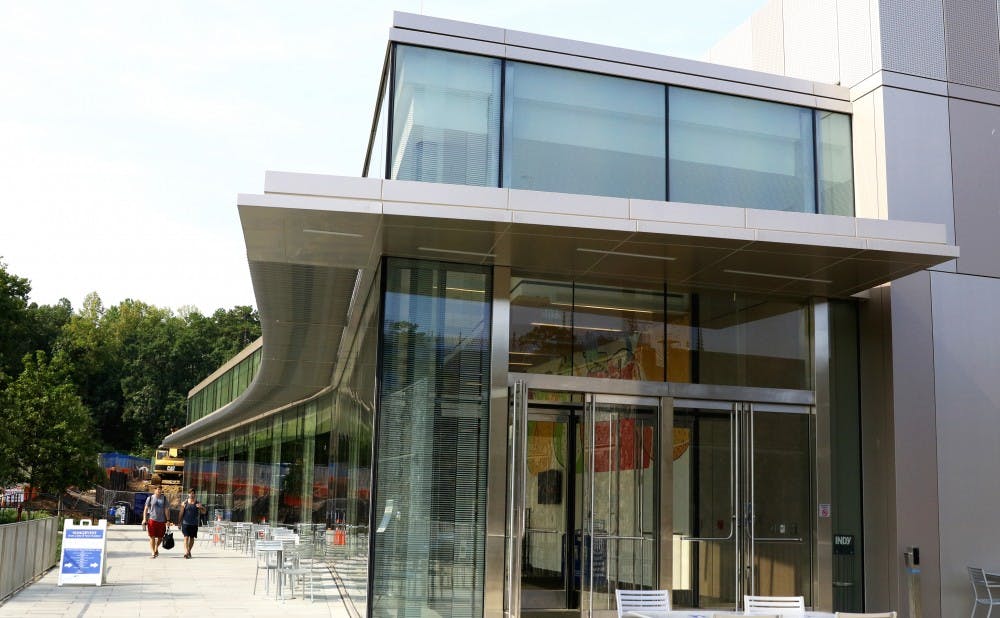Although Duke is widely known for its neo-Gothic West Campus towers, most students know little about architecture’s elements of style or alternative forms. To curb this trend, the Literature department invited architectural theorist and historian K. Michael Hays to give a public lecture titled “Phenomenality, Materiality, and Inscription: Trends in Contemporary Architecture” Wednesday.
Hays, the Eliot Noyes Professor of Architectural Theory at Harvard University's Graduate School of Design, discussed the structure of contemporary buildings, some of which were designed only in the last few years, often by architects in their ‘30s or ‘40s. An exhibition titled “Inscriptions: Architecture before Speech,” which Hays and his colleague Andrew Holder had put together earlier this year, served as the background for the buildings discussed.
“Architecture is something that you experience in distraction,” Hays said, paraphrasing philosopher Walter Benjamin.
Hays said individuals sometimes lose sight of the architectural wealth they experience.
“Architecture is a background phenomenon for most of us — when we watch a movie, we attend, we focus," Hays said. "In architecture, you don’t tend to focus if you’re not an architect."
The designs in the presentation included the PS1 Dolmen by First Office, Wolfsburg Science Center by Mack Scogin Merrill Elam or Project 28 by Preston Scott Cohen. Hays said that they were generally “immature and experimental, but very now.”
Interestingly, very few of the designs presented were ever used in reality, rendering them “paper architecture.” Citing philosopher Nelson Goodman, Hays explained that this had to do with architecture’s status as an “allographic art,” similar to music. This means that unlike classic sculpting or painting, music and architecture have “notational systems” that rely on others to be put into practice. Architectural drawings thus become the object of heightened interest because “an architect is thinking as they draw.”
In general, contemporary architecture can be understood as a reaction to its preceding movement: postmodernism. Although the term is widely used in several fields, ranging from literature to politics, postmodern architecture was particularly prominent in the 1970s and 80s, when it was first theorized by Robert Venturi, Denise Brown, Aldo Rossi and Manfredo Tarfuri. Prominent examples include the Portland Building by Michael Graves and the Haas School of Business in Berkeley. Along with many other factors, postmodern architecture itself had been driven by a rebellion against the functional and plain style of modernism, as exemplified by the works of Mies van der Rohe, Le Corbusier or Frank Lloyd Wright.
A focal point of the drawings and pictures shown was the question of materiality, defined as the combination of material and form. Several young architects explicitly emphasized their decision to use dirt, hay, concrete or materials won from recycled waste in their designs. One of the projects presented even featured several cow bodies used as construction material — an attempt to escape traditional notions of material in an endeavor to become “post-natural” or “post-rock.” Hays said that all this may not produce anything like “direct meaning,” as had been the main concern for their postmodern predecessors, but it certainly incorporates an increased environmental conscience.
Theoretically, the lecture drew heavily on the thought of Immanuel Kant, Duke Professor Fredric Jameson and, most importantly, Jacques Lacan. Hays’s approach uses Lacanian psychoanalysis as a systematic tool for the study of architecture, which allows for a categorization of style and form, along with the relations between individual elements. Although he was probably not the first to combine Lacan and architecture, Hays said he was the one who had done it with the most enthusiasm, citing the biases around psychoanalysis that persist in academia.
“We can also make buildings legible, not by turning people into designing architects but just talking about elements, principles and processes,” he said.
Those interested in acquiring a deeper apprehension for the buildings around them are in luck, as Hays and his colleagues at Harvard now offer a free online course titled “The Architectural Imagination,” but it is not a traditional course on the history of architecture.
“We tried to show in several historical examples what the parameters were for understanding the underlying value systems,” Hays said. “Buildings, including Duke’s neo-Gothic campus, have a lot more to say than what we presume."
Get The Chronicle straight to your inbox
Signup for our weekly newsletter. Cancel at any time.

